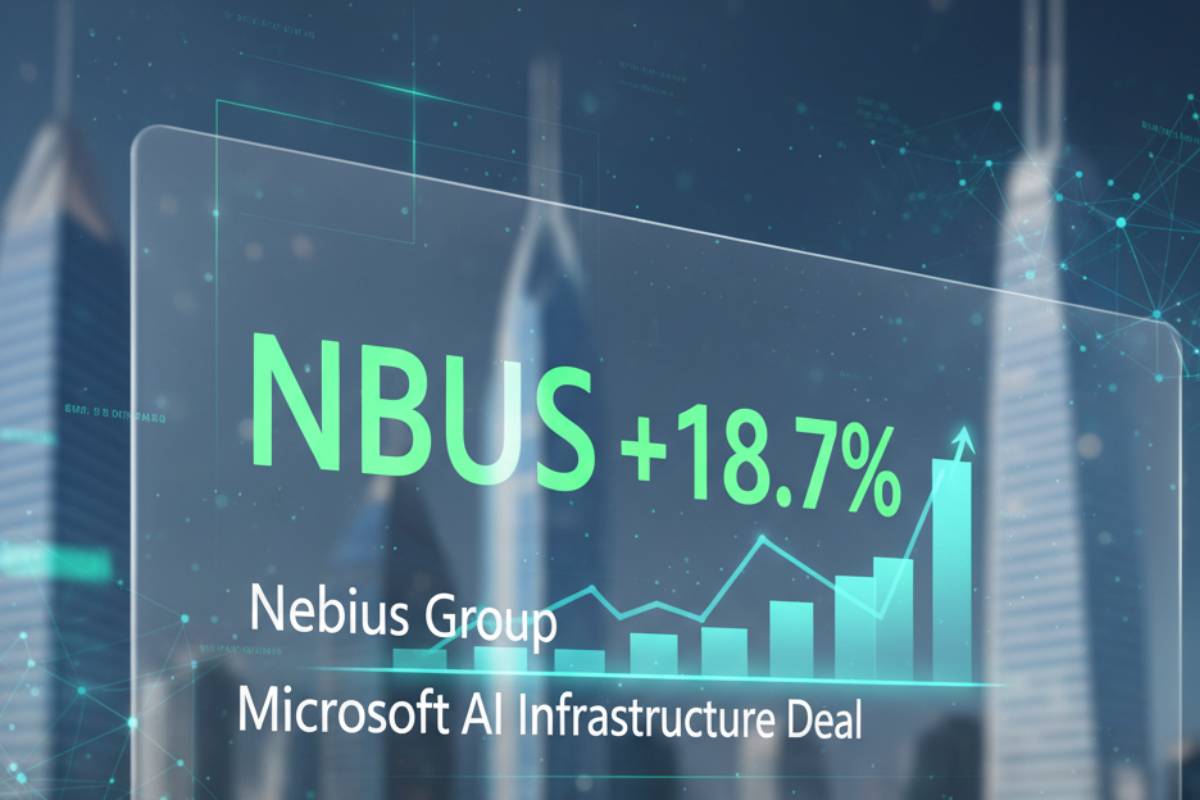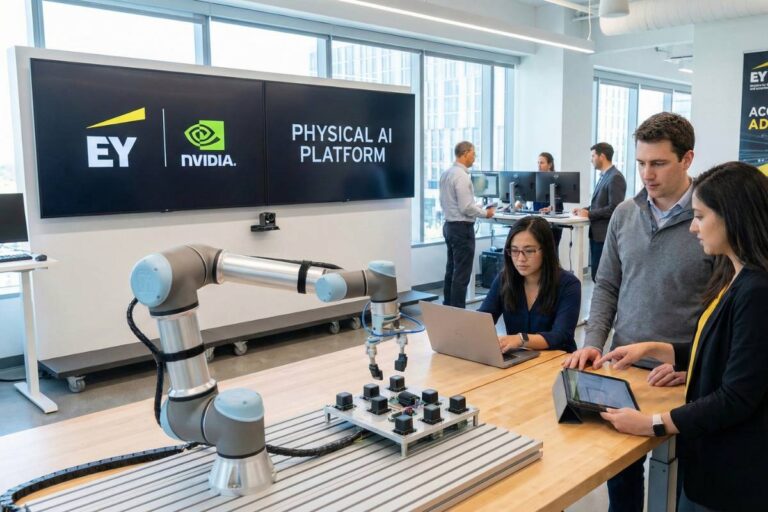The Nebius Group N.V. Wall Street is paying attention to (NASDAQ: NBIS). Recently, the stock rose 16.6% thanks to a historic multi-billion-dollar deal with Microsoft that is changing the way AI infrastructure works. This isn’t just another tech partnership; it’s proof that Nebius has changed from being a leftover from a Russian internet company to a serious player in the high-stakes world of artificial intelligence computing.
The deal, which is worth $17.4 billion over five years, could go up to $19.4 billion if Microsoft uses more capacity options. The company is based in Amsterdam. And what about the market? It really liked everything about it. Shares shot up more than 50% when the news broke in early September, and they have kept going up since then, trading close to their 52-week high of $141.10.
Information About the Microsoft Partnership
Microsoft will be able to use more than 100,000 Nvidia GPUs that are stored at Nebius’s new data center in Vineland, New Jersey. This is what makes this deal so interesting. That’s not just computing power; that’s the kind of infrastructure that tech companies are racing to build so they can train huge language models and power the next generation of AI assistants.
The deal starts later this year and gives Microsoft dedicated GPU infrastructure capacity for the next five years. It includes a guaranteed minimum payment of $17.4 billion, but Microsoft can buy more services or capacity, which could bring the total value to about $19.4 billion.
Arkady Volozh, the CEO and founder of Nebius, was very excited when he announced the partnership:
“The deal’s economics are good on their own, but what’s even better is that it will help us grow our AI cloud business even faster in 2026 and beyond.”
He also hinted that this is just the beginning, the first of what Nebius hopes will be many long-term deals with top AI labs and big tech companies.
Learning About Nebius Group’s Path
You need to know where Nebius came from to understand where it is now. The company’s origin story sounds like a geopolitical thriller. The company started out as Yandex N.V. in 1989. Arkady Volozh started the company as a holding company for Yandex, which is often called the “Google of Russia.” The company went through a huge change.
When Russia invaded Ukraine in February 2022, the world put a lot of pressure on it. Nasdaq stopped trading Yandex shares, and Volozh himself was put on the European Union’s list of people who are not allowed to do business with the EU. In July 2024, a group of Russian companies paid $5.4 billion to buy Yandex’s Russian assets. This was one of the biggest corporate exits since the invasion began.
What emerged from this split was Nebius Group, retaining businesses that worked outside of Russia:
- AI infrastructure operations
- Autonomous driving technology company Avride
- Edtech platform TripleTen
In March 2024, the EU took Volozh off the sanctions list, making it possible for him to come back as CEO of this new version.
After being suspended for months, Nebius shares started trading again on Nasdaq in October 2024 under the new ticker NBIS. The first day of trading for the IPO was rough. Shares fell 26% in pre-market trading, but they rose 5.6% by the end of the day, ending at $20 per share.
Demand for AI Infrastructure Drives Growth
They say that timing is everything. And Nebius’s switch to AI infrastructure couldn’t have come at a better time. The world needs a lot more high-performance computing resources in 2025 because generative AI, machine learning applications, and training large language models are all becoming more popular very quickly.
Look at the numbers:
- Nvidia gave almost 60% of its chip production to enterprise AI clients in the first quarter of 2025. This made it very hard for consumers to get GPUs.
- In January 2025, a 6.4 magnitude earthquake hit TSMC’s facilities and damaged more than 30,000 high-end wafers that were needed to make GPUs. This made the supply even tighter.
- High-end GPUs like the RTX 5090 have been selling for 30–50% more than their MSRP because they are hard to find.
This imbalance between supply and demand has led to what industry insiders call the “GPU gold rush,” and Nebius put itself right in the middle of it. In the second quarter of 2025, the company’s sales jumped 625% from the same time the year before, reaching $105.1 million. Sales of AI cloud infrastructure grew more than nine times from the year before.
What is causing this rapid growth? Almost all of the GPUs are being used, and there is a huge demand for what Nebius calls “copper GPUs,” which are the high-performance processors that AI models need to be trained. Nebius hopes to have 220 megawatts of connected power by the end of 2025, either active or ready to be used by GPUs. Looking ahead to 2026, the company’s goal becomes even bigger: more than 1 gigawatt of power capacity.
How the Stock Market Reacted
Let’s talk about numbers that are important to investors. Nebius stock has been on an absolute tear in 2025. The shares have more than tripled this year, and as of mid-October, they had a return of 314.06% year-to-date. The stock price has gone up an incredible 505.57% in the last year.
Recent momentum has been particularly strong:
- In the month following the Microsoft deal announcement, NBIS gained 48.9%, vastly outperforming the Zacks Computer & Technology sector’s 1.8% gain and the S&P 500’s small 0.4% gain during the same time.
- In the middle of October, the stock was trading at $135.46, which was close to its 52-week high of $141.10.
- The three-month performance is even more shocking: shares rose by 117.27% during that time.
- That 16.6% rise came because people were feeling good about the company’s strategic position and the ongoing boom in AI infrastructure.
Market analysts have also noticed. After Microsoft announced the deal, a number of companies raised their price targets. For example, some analysts raised Nebius’s target price from $75 to $125. Some predictions say the fair value is $153.00, which would be a 22% increase from recent trading levels.
Technical indicators also show that the market is going up. The stock has been trading above its 50-day and 100-day moving averages, which means that it is still going up.
Financial Structure and Plan for Growth
From a business strategy point of view, this is where things get interesting. Nebius doesn’t want to pay for the Microsoft contract’s capital expenses just with the cash they already have. Instead, the company is using a multi-pronged approach to financing that is both realistic and ambitious.
The main way to get money is by using cash flow from the Microsoft deal and issuing debt that is backed by the contract. Nebius can get better borrowing terms because Microsoft has good credit. Basically, it’s using Microsoft’s AAA credit rating as security to get better terms on a loan.
But that’s not everything. According to company statements, Nebius is also looking into “a number of additional financing options to enable significantly faster growth than originally planned.” This makes it seem like the Microsoft deal has given management the confidence to go after even bigger growth than they had planned.
The company’s plans for bigger investments are big:
- Before Microsoft made its announcement in September 2024, Nebius had already promised to spend more than $1 billion on AI infrastructure in Europe by the middle of 2025.
- In December 2024, the company raised $700 million in a funding round that included Nvidia (which bought 0.5% of Nebius) and Accel Partners. This made the company’s capital position much stronger.
- Nebius expected its sales to grow by three to four times in 2025, reaching between $500 million and $700 million.
- To support this growth path, planned capital spending ranges from $600 million to $1.5 billion to increase the capacity of data centers in Finland, France, and North America.
The Competitive Landscape
Nebius doesn’t work in a vacuum. The business goes up against well-known companies like CoreWeave, which counts Microsoft as its biggest customer. When Nebius announced its deal with Microsoft, CoreWeave’s shares went up 8% in sympathy trading. This shows that investors are positive about the whole sector.
But the way that companies compete is changing. Amazon Web Services, Microsoft Azure, and Google Cloud are examples of traditional hyperscale cloud providers that have historically had a lot of power in the enterprise AI infrastructure market. But a new type of specialized provider, often called “neoclouds,” has come along to solve problems that older providers have trouble with, like making GPUs available right away and offering more flexible pricing.
Nebius fits perfectly into this neocloud group. The company gives AI developers the computing power, storage space, managed services, and tools they need to create, fine-tune, and run AI models. Nebius stands out because it says it has a “full stack of purposefully designed and tuned proprietary software and hardware designed in-house.”
This strategy of vertical integration is in line with what is happening in the rest of the industry. The $300 billion Stargate Project from Oracle and other AI Infrastructure Partnership (AIP) consortium projects show how important vertical integration has become for getting computational benefits.
The GPU supply chain is still the biggest problem in the industry. Nvidia and AMD are now the two biggest suppliers of GPUs. Nvidia has especially benefited from its CUDA software ecosystem, which has become the standard for AI workloads. Nebius’s ability to get a lot of Nvidia GPUs, like the 100,000+ units it promised to Microsoft, gives it a big edge over its competitors.
Expanding the Infrastructure of Data Centers
In this business, physical infrastructure is very important, and Nebius has been building a lot. The company is currently doing business:
- A data center in Mäntsälä, Finland, serving as one of its main European hubs
- A GPU cluster at an Equinix data center in Paris, providing capacity in a key European market
- A GPU cluster at a Kansas City, Missouri, data center is under construction
- The flagship 300MW data center in Vineland, New Jersey, is also under construction, and this is where Microsoft’s dedicated capacity will be stored
That building in New Jersey is a very important asset. The data center is in Vineland and is made just for heavy AI workloads. It will be the delivery point for the Microsoft contract starting in late 2025.
Energy infrastructure is now just as important as computing infrastructure in the race for AI. AI workloads often go over 50kW per rack, which is a lot more than what traditional data centers can handle. This has forced 52% of facilities to upgrade their power systems. Analysts say this has made a $1 trillion investment opportunity in energy.
Nebius’s goal of getting more than 1 gigawatt of power capacity by the end of 2026 means that the company will be able to handle huge AI training workloads. In other words, 1 gigawatt could theoretically power about 750,000 homes or tens of thousands of high-performance GPUs that are always on.
Revenue Growth and Profitability
Let’s talk about the company’s financial performance that has investors excited. In the second quarter of 2025, Nebius’s AI cloud infrastructure revenues grew by more than nine times compared to the same time last year. The total amount of money made was $105.1 million, which is 625% more than the same time last year.
The company also did something that many fast-growing tech startups have trouble with: making money. According to management comments from the last earnings call, Nebius’s core AI infrastructure business became EBITDA positive “ahead of projections.”
This milestone in terms of profit is very important. While building capacity and market share, many AI infrastructure companies lose a lot of money. Nebius has found product-market fit with good unit economics since it has positive EBITDA and revenue growth in the triple digits.
For the whole year 2025, revenue estimates range from $500 million to $700 million, which is three to four times what it was in 2024. The Microsoft deal alone will bring in a lot of money in the future, but when the money is recognized will depend on when capacity is delivered and how it is accounted for.
The company’s guidance points to even faster growth in 2026. CEO Volozh said clearly that the Microsoft deal “will help us to accelerate the growth of our AI cloud business even further in 2026 and beyond.” This suggests that management thinks the deal will give the company more operational leverage, which will help the whole business, not just bring in contract revenue.
What This Means for Strategy
What else does the Microsoft partnership mean besides the money it will make right away? Because it proves that Nebius’s business model works at the highest level. Getting a five-year, multi-billion-dollar commitment from one of the world’s most advanced tech companies sends a strong message to the market about Nebius’s ability to run a business, dependability, and technical skills.
The deal fixes what Volozh called “data center capacity shortages in the industry,” which has been a problem for a long time and has slowed down AI development across the board. Microsoft makes sure it won’t run into problems with GPU availability while it works on its AI assistant technologies and large language models by getting dedicated, long-term capacity.
The strategic value for Nebius goes beyond Microsoft. The contract shows that the company can deliver at hyperscale, which makes it a good partner for other “leading AI labs and big tech companies,” as Volozh hinted. The CEO’s statement that “there is more to come” suggests that they are actively negotiating for more big contracts.
This optimism is backed up by the state of the industry:
- By 2025, AI is expected to use a large amount of global computing resources, which will increase the need for infrastructure that is ready for high-performance computing (HPC).
- NVIDIA’s CEO, Jensen Huang, called AI infrastructure “the backbone of the fourth industrial revolution.”
- Microsoft’s CEO, Satya Nadella, talked about how important it is to make the economy more competitive.
The total addressable market is huge. During an earnings call, NVIDIA’s CFO Colette Kress said that the company expects its spending on AI infrastructure to reach between $3 trillion and $4 trillion by the end of the decade. Even getting a small part of that market would make Nebius a lot of money.
Things to Think About and Risks
Any investment thesis that doesn’t talk about risks isn’t complete, and Nebius has a lot of them to think about. The stock’s quick rise, more than tripling this year, has led to questions about its value. Some analysts have changed their minds about the stock and now say to “Sell” because they are worried about “rapid stock appreciation and hype-driven valuation.”
Execution risk is very high. It is a huge job to set up 300MW of data center space, secure and install over 100,000 GPUs, and get everything up and running. Any delays could hurt the company’s reputation with its most important client and affect when it can recognize revenue.
Financing risk also deserves attention. Nebius’s plan to pay for growth with a mix of operating cash flow, secured debt, and other financing options sounds good, but the amount of money needed makes it risky. The company’s 6-K filing with the SEC lists a number of risks that could happen in the future, such as the ability to “obtain on acceptable terms the additional financing required for the capital expenditures” related to the Microsoft contract.
Competition remains fierce. CoreWeave, Microsoft’s biggest current supplier of GPU infrastructure, has built relationships and a history of successful operations that Nebius must match. Not only are neocloud providers competing in the larger market, but traditional hyperscalers are also putting more money into building their own AI infrastructure.
Market dynamics could shift. Right now, the lack of GPUs is good for infrastructure providers, but as manufacturing capacity grows, supply problems may improve over time. If GPUs become more widely available, prices could go down, which could lower profits across the board.
Geopolitical concerns haven’t gone away completely. Some investors may still be wary of Nebius because it is based in Russia, and Volozh was taken off the EU sanctions lists.
Why Investors Are Excited
Even with these risks, the bull case for Nebius is still strong. The company gives investors pure-play exposure to AI infrastructure demand without the high prices that come with established tech giants. Nebius gives investors who think AI adoption will keep going up more upside to that trend.
The Microsoft deal gives them a clear picture of their long-term revenue, which is very important for tech companies that are growing quickly. Many startups spend a lot of money to get customers, but Nebius has found a creditworthy partner who will pay them at least $17.4 billion over five years.
The growth story is backed up by operational metrics:
- Near-peak GPU usage rates show that there is a lot of demand for the company’s current capacity.
- Getting EBITDA to be positive ahead of schedule means that the business model works at its current size, and as the company becomes more efficient at a larger scale, it may be able to increase its margins.
The managers have experience that is useful. Before the split, Arkady Volozh turned Yandex into a multibillion-dollar tech giant. That operational know-how, along with a lot of technical know-how and a track record of being able to grow technology infrastructure, gives you confidence in your ability to get things done.
It looks like strategic positioning is strong. Nebius can meet the needs of customers with different data residency requirements because it has data centers in Finland, France, and the United States. The company’s vertical integration strategy, which includes making its own software and hardware, could set it apart from competitors that only use third-party technology.
The market that can be reached is still very large and not very well served. Companies are still in the early stages of adopting AI technologies. Most of them are just starting to look into how generative AI, machine learning, and advanced analytics can change the way they do business. As more traditional businesses start to use AI, the need for AI infrastructure should keep rising.
Analysts’ Views and Price Goals
After Microsoft made its announcement, Wall Street analysts have become more and more positive about NBIS. Some analysts have raised their price targets from $75 to $125, which is a 67% increase. This shows that they are becoming more confident in the company’s future.
One study says the fair value is $153.00 based on revenue forecasts and the values of similar companies. This means that the stock could go up about 22% from where it was trading in mid-October, when it was around $135. This way of figuring out the value probably takes into account the Microsoft contract revenues, the expected growth of the core AI cloud business, and the market multiples for other companies that provide similar infrastructure.
But not all analysts are as hopeful as this. Some have given “Sell” ratings, saying that the recent rise in stock prices has outpaced improvements in the company’s fundamentals and that the current valuations include a lot of uncertain future execution. These bearish analysts say that rapid growth could lead to risks, operational problems, and what they call “hype-driven” investor excitement.
The different opinions show that people really don’t know how to value a company like Nebius, which is new to the market, growing at an incredible rate, working in a new sector, and just signed a big deal that will change everything.
The Bigger Picture in the Industry
Nebius’s growth is a sign of bigger changes in the tech infrastructure world. The rise of specialized neocloud providers makes it harder for traditional hyperscalers to stay on top in certain areas. These agile competitors can often move faster, offer more tailored solutions, and provide better value for certain workloads than public clouds that work for everyone.
Strategic partnerships are now the most important part of building AI infrastructure:
- NVIDIA is a technical advisor for the Global AI Infrastructure Investment Partnership (GAIIP)
- Oracle is working on the huge Stargate Project
- There are many other public-private partnerships
These show that no one company can build the necessary infrastructure on its own.
Energy infrastructure has become a major problem. The 52% of data centers that are upgrading their power systems to handle AI workloads is only the beginning of what some people think will cost $1 trillion to build up energy infrastructure. Companies like GE Vernova and BlackRock have become important players by providing the energy and money needed to fuel AI’s rapid growth.
Market leaders are companies that control important chokepoints, like GPU suppliers (NVIDIA and AMD), energy enablers (GE Vernova and major utilities), and infrastructure providers that can get both GPUs and power at scale (CoreWeave and Nebius). This trend toward consolidation means that companies like Nebius that get ahead of the competition early on may be able to keep their advantages.
What Happens Next
Execution is the most important thing for Nebius right now. The company’s most important short-term goal is to meet the Microsoft contract deadline, which includes bringing the Vineland, New Jersey data center online and setting up more than 100,000 Nvidia GPUs. If this works out, it proves the business model and opens up more opportunities for enterprise contracts.
Volozh said that getting more “long-term committed contracts with leading AI labs and big tech companies” would make the growth story even less risky. Having a lot of big contracts would lower the risk of having too many customers in one place and give you an even better view of your revenue.
Decisions about financing strategies are very important. The company has said it will “update the market on its financing strategy in due course” about options that will allow for “significantly faster growth than originally planned.” The choice of equity financing, more secured debt, strategic partnerships, or other sources of capital will have a big effect on dilution and financial flexibility.
Timelines for expanding capacity are very important. If Nebius can reach its goal of getting more than 1 gigawatt of power capacity by the end of 2026, it will be one of the largest independent AI infrastructure providers in the world. Problems or delays in getting power, real estate, or GPUs could limit growth.
It will be interesting to see how CoreWeave and other competitors respond. Will other infrastructure providers be able to match Nebius’s prices, service levels, or technical skills? Or will Nebius’s early success bring in even more competitors in a market that is already full?
Final Thoughts
The 16.6% rise in Nebius Group’s stock price is more than just short-term momentum. It shows that investors know the company is at the center of one of the most important infrastructure build-outs in technology. The Microsoft deal proves that Nebius has changed from a spinoff with uncertain future prospects into a serious player in the multi-trillion-dollar AI infrastructure market.
The company’s journey from being a leftover from Yandex to being an AI infrastructure provider traded on the Nasdaq sounds like a story of redemption. Arkady Volozh’s ability to deal with geopolitical turmoil, carry out a complicated corporate split, and switch to one of the hottest areas of technology shows both resilience and strategic vision.
Nebius’s ability to keep up its amazing momentum depends on things that management can and can’t control, like how well it can execute, how competitive the market is, how demand is changing, and how the economy as a whole is doing. The stock’s huge gains this year have raised expectations so high that there isn’t much room for disappointment.
For investors, Nebius is a risky but potentially profitable investment. If the Microsoft contract is delivered successfully, there are more big customer wins, revenue growth continues to be explosive, and margins keep getting bigger, the stock could go up a lot from where it is now. The story could just as easily be derailed by the downside scenario, which could include problems with execution, more competition, or a general slowdown in AI infrastructure spending.
What’s undeniable is that Nebius has secured its seat at the table. In a field where having access to GPUs and power capacity determines who wins and who loses, the company has shown that it can compete with the best. The partnership with Microsoft gives the company money and credibility to go after even bigger growth goals.
As AI keeps changing the way companies do business and compete, the infrastructure that makes that change possible will only get more valuable. Nebius is betting that specialized companies that offer purpose-built AI infrastructure can take a big chunk of the market from both established cloud giants and new neocloud competitors. We’ll find out in the next few quarters if that bet pays off and if the stock’s recent rise is the start of a longer run or just a peak that will be hard to keep up.
















